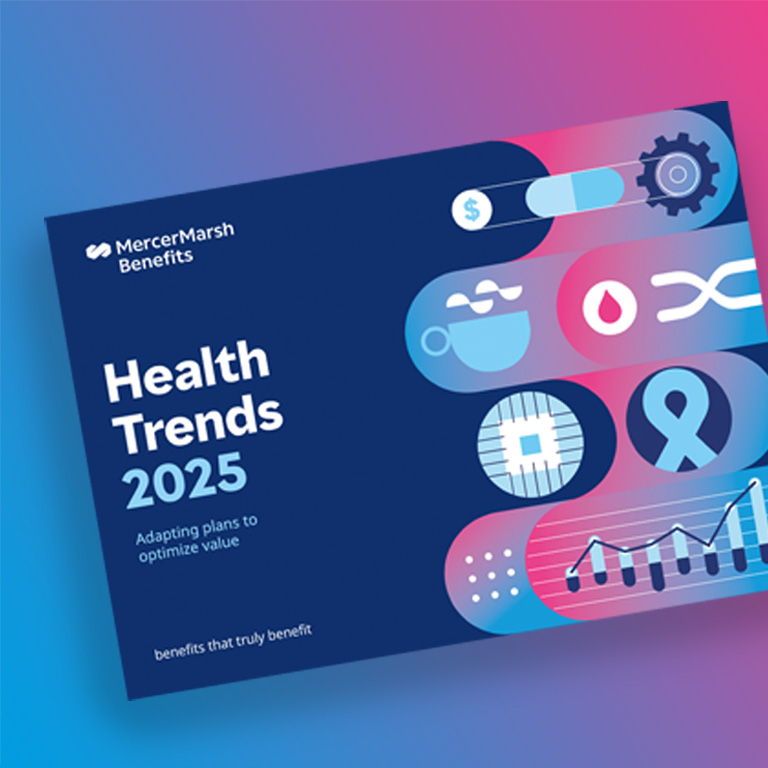
Hannah Proctor
MMB Multinational Network Leader, Asia and Pacific
-
Singapore
Mercer Marsh Benefits (MMB) new research MMB’s Health Trends into global medical trends shows the challenges facing organisations, both globally and in emerging markets.
Medical trend rates have outpaced inflation for several years, but were muted in many countries by the pandemic. Now, as more people seek treatment for COVID-19 and non-COVID-19 conditions, the cost of employer-sponsored health benefits is escalating.
The medical trend is the year-over-year cost increase for claims under a medical plan on a per-person basis. It reflects a variety of factors including:
Our research shows that medical trend rates rebounded in 2021, and this is set to continue in 2022, with a predicted global rate of 9.5%.
There are also important geographic differences leading to regional variation. For instance, the Middle East and Africa, and Asia regions all had higher than average medical trends rates.
Source: Rates for 2020 are retrospective. Rates for 2021 and 2022 are prospective.
In Asia, in our experience medical inflation typically results in the underlying cost of care increasing year over year, which we also note is a global phenomenon and is usually around 10% per year in most countries.
However, due to the unique circumstances that government mandated Movement Control Orders (i.e. Lockdowns) created in some of the developing countries in Asia (notably, Indonesia, Malaysia and Philippines), employees in 2020 actually underutilised their healthcare plans as they were at home rather than going to their doctor and seeking treatment. This created a negative medical trend for these geographies, leading to some clients seeing reductions in their insurance premiums in 2021 against the prior year.
This trend is not predicted to continue, and MMB forecast that medical inflation rates are likely to return to pre-pandemic levels (and beyond). We are proactively working with clients to consider relevant and future-proof cost management measures to ensure preparedness for renewal rates on health insurance policies in 2023.
In Latin America and the Caribbean our research shows that 85% of insurers reported seeing higher life insurance claims, especially in Colombia, Mexico and Panama.
In part, these higher insurance costs are driven by the COVID-19 pandemic. Almost 90% of insurers in Latin America expect to bear the costs of inpatient COVID-19 treatments, and over 50% of insurers in Asia and the Middle East expect to cover outpatient treatments related to the pandemic.
If the crisis continues, more insurance claims may lead to higher premiums, tighter underwriting practices or exclusions. For example, in India, we have seen insurers reduce product availability, and require vaccine records before offering renewal terms.
Of course, COVID-19 isn’t the only issue at play in rising medical trends. Non-communicable health conditions are a top concern, with insurers ranking metabolic and cardiovascular risk as the top factor influencing employer-sponsored group medical costs.
Insurers reported cancer as the top cause of claims costs by dollar amount - both globally and in the Asia, and Latin America regions. Meanwhile, diseases of the circulatory system were identified as the top driver of claims by frequency, and the top cause of claims by dollar amount in the Middle East and Africa.
Non-communicable diseases (NCDs) kill 41 million people each year, amounting to 71% of all deaths globally. Reducing NCDs must be a key priority for employers and insurers, for both the health of their employees and their businesses.
The pandemic affected how people interacted with the healthcare system, and how they behaved with regards to their well-being. For instance, a study of breast cancer detection in Taiwan found that the percentage of early breast cancer diagnoses decreased from 71% to 49% once the COVID-19 pandemic hit.
Research by American Health & Drug Benefits shows that early intervention not only improves cancer survival rates and treatment success, it also decreases claims costs. This research also concluded that: “Knowledge of the relevant stage-specific cost data provides support for strengthening programs, such as breast cancer screening, that are designed to shift breast cancer diagnosis to earlier disease stages.”
This is just one example, but it demonstrates why it is important to encourage employees to continue with preventive care, such as annual health screening, and to ensure they respect local guidelines and restrictions.
The pandemic is also having long-term impacts on healthcare access in the area of chronic disease management. There are good examples of how firms can help. In the Middle East, for example, telemedicine providers let members easily obtain refill prescriptions without incurring consultation costs. This not only helps members who no longer need to travel to a hospital or clinic, but also saves costs for the employers on outpatient expenses.
Basic health education can boost awareness and help build a health culture. This is a popular solution in the Middle East, but the quality of providers is quite variable. Employers should consider creating feedback channels for workers – this will help identify high quality providers and enhance overall engagement.
Employers should:
Insurers are understandably cautious about predicting when medical claims will return to ‘normal’. Take up of health services and preventative care will depend on how the pandemic evolves. That means that managing claims uncertainty is a crucial part of the puzzle for employers.
January 2022 renewals are beginning to tell a story in countries such as India and the Philippines where hospital footfall is returning back to pre-pandemic levels. This is good news if it means people are getting the preventative and/or diagnostic care they need. And, while firms could see a short-term increase in the insurance premiums they pay, this could also translate to lower costs in the long term as conditions are identified and treated earlier.
Due to the strict COVID-19 zero policies in China and Hong Kong, MMB has seen that hospital footfall is still below pre-pandemic levels with commensurate adjustments in January renewal insurance premiums.
It is critical to manage your plan throughout the year not just at renewal. This helps you to better understand claim drivers and manage costs. An annual benefit cycle with quarterly experience reviews can help employers predict future claims activity and reduce the risks of volatility.
This means considering factors such as how the plan is designed, financed, administered, communicated, risk managed and governed. Firms will also benefit from staying in tune with employee needs, monitoring trends and heightened awareness of legislative changes.
Being appointed as a broker allows MMB to take a more detailed data-driven approach. In the UAE, for example, we have the teams and tools to analyse data by type of outpatient, inpatient and pharmaceutical claims. Depending on how these trends develop over the policy period, we can then work with clients on bespoke cost savings solutions.
Developing a clear strategy and planning for renewals well in advance means that you can better control costs. This should be done as part of a cost containment framework that educates stakeholders on benefits as investment not a cost.

MMB Multinational Network Leader, Asia and Pacific
Singapore

Head of Consulting, Mercer Marsh Benefits, MENA
United Arab Emirates
We provide a range of solutions to help you manage the health and well-being of your workforce, including:

Article
13/10/2024